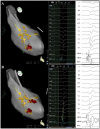Ventricular fibrillation ablation in cardiomyopathies and arrhythmic storm
- PMID: 34650368
- PMCID: PMC8503529
- DOI: 10.1093/eurheartj/suab104
Ventricular fibrillation ablation in cardiomyopathies and arrhythmic storm
Abstract
Sudden cardiac death (SCD) is a relevant contributor to cardiovascular mortality, often occurring as a dramatic event. It can be the consequence of a ventricular tachycardia/fibrillation (VT/VF), a common and life-threatening arrhythmia. The underlying mechanisms of this catastrophic arrhythmia are poorly known. In fact, it can occur in the presence of a structural heart condition which itself generates the suitable substrate for this arrhythmia. Nevertheless, a VF may cause SCD also in young and otherwise healthy individuals, without overt structural abnormalities, generating difficulties in the screening and prevention of these patients. The implantable cardioverter-defibrillator represents the only therapy to contrast SCD by treating a VT/VF; however, it cannot prevent the occurrence of such arrhythmias. Catheter ablation is emerging as an essential therapeutic tool in the management of patients experiencing ventricular arrhythmias.
Keywords: Ablation; BrS; Idiopathic VF; PVC; Purkinje; Substrate.
Published on behalf of the European Society of Cardiology. © The Author(s) 2021.
Figures



Similar articles
-
Interventional electrophysiology and its role in the treatment of cardiac arrhythmia.Ann Acad Med Singap. 1998 Mar;27(2):248-54. Ann Acad Med Singap. 1998. PMID: 9663319 Review.
-
Catheter Ablation of Ventricular Fibrillation.Heart Lung Circ. 2019 Jan;28(1):110-122. doi: 10.1016/j.hlc.2018.09.005. Epub 2018 Sep 29. Heart Lung Circ. 2019. PMID: 30301669 Review.
-
Dofetilide reduces the frequency of ventricular arrhythmias and implantable cardioverter defibrillator therapies.J Cardiovasc Electrophysiol. 2012 Mar;23(3):296-301. doi: 10.1111/j.1540-8167.2011.02183.x. Epub 2011 Sep 28. J Cardiovasc Electrophysiol. 2012. PMID: 21955243
-
Catheter Ablation of Ventricular Fibrillation.Card Electrophysiol Clin. 2022 Dec;14(4):729-742. doi: 10.1016/j.ccep.2022.06.002. Epub 2022 Oct 28. Card Electrophysiol Clin. 2022. PMID: 36396189 Review.
-
Long-term follow-up in patients with arrhythmogenic right ventricular cardiomyopathy.J Cardiovasc Electrophysiol. 2012 Jul;23(7):750-6. doi: 10.1111/j.1540-8167.2011.02288.x. Epub 2012 Feb 21. J Cardiovasc Electrophysiol. 2012. PMID: 22353378
Cited by
-
Catecholaminergic Polymorphic Ventricular Tachycardia: Advancing From Molecular Insights to Preclinical Models.J Am Heart Assoc. 2025 Mar 18;14(6):e038308. doi: 10.1161/JAHA.124.038308. Epub 2025 Mar 13. J Am Heart Assoc. 2025. PMID: 40079282 Free PMC article. Review.
-
The Role of Human-Induced Pluripotent Stem Cells in Studying Cardiac Channelopathies.Int J Mol Sci. 2024 Nov 8;25(22):12034. doi: 10.3390/ijms252212034. Int J Mol Sci. 2024. PMID: 39596103 Free PMC article. Review.
-
PARP9 affects myocardial function through TGF-β/Smad axis and pirfenidone.Biomol Biomed. 2024 Sep 6;24(5):1199-1215. doi: 10.17305/bb.2024.10246. Biomol Biomed. 2024. PMID: 39213416 Free PMC article.
-
Fascicular/Purkinje Tissue Colocalized With Scar in Cardiomyopathy Patients Undergoing Ventricular Fibrillation Ablation.Pacing Clin Electrophysiol. 2025 Jul;48(7):672-681. doi: 10.1111/pace.15215. Epub 2025 Jun 2. Pacing Clin Electrophysiol. 2025. PMID: 40455574 Free PMC article.
-
Purkinje network and myocardial substrate at the onset of human ventricular fibrillation: implications for catheter ablation.Eur Heart J. 2022 Mar 21;43(12):1234-1247. doi: 10.1093/eurheartj/ehab893. Eur Heart J. 2022. PMID: 35134898 Free PMC article.
References
-
- Priori SG, Blomström-Lundqvist C, Mazzanti A, Blom N, Borggrefe M, Camm J, Elliott PM, Fitzsimons D, Hatala R, Hindricks G, Kirchhof P, Kjeldsen K, Kuck K-H, Hernandez-Madrid A, Nikolaou N, Norekvål TM, Spaulding C, Van Veldhuisen DJ; ESC Scientific Document Group. 2015 ESC Guidelines for the management of patients with ventricular arrhythmias and the prevention of sudden cardiac death: the Task Force for the Management of Patients with Ventricular Arrhythmias and the Prevention of Sudden Cardiac Death of the European Society of Cardiology (ESC). Endorsed by: Association for European Paediatric and Congenital Cardiology (AEPC). Eur Heart J 2015;36:2793–2867. - PubMed
-
- de Noronha SV, Behr ER, Papadakis M, Ohta-Ogo K, Banya W, Wells J, Cox S, Cox A, Sharma S, Sheppard MN.. The importance of specialist cardiac histopathological examination in the investigation of young sudden cardiac deaths. Europace 2014;16:899–907. - PubMed
-
- Ozaydin M, Moazzami K, Kalantarian S, Lee H, Mansour M, Ruskin JN.. Long-term outcome of patients with idiopathic ventricular fibrillation: a meta-analysis. J Cardiovasc Electrophysiol 2015;26:1095–1104. - PubMed
-
- Haïssaguerre M, Shah DC, Jaïs P, Shoda M, Kautzner J, Arentz T, Kalushe D, Kadish A, Griffith M, Gaïta F, Yamane T, Garrigue S, Hocini M, Clémenty J.. Role of Purkinje conducting system in triggering of idiopathic ventricular fibrillation. Lancet 2002;359:677–678. - PubMed
-
- Knecht S, Sacher F, Wright M, Hocini M, Nogami A, Arentz T, Petit B, Franck R, De Chillou C, Lamaison D, Farré J, Lavergne T, Verbeet T, Nault I, Matsuo S, Leroux L, Weerasooriya R, Cauchemez B, Lellouche N, Derval N, Narayan SM, Jaïs P, Clementy J, Haïssaguerre M.. Long-term follow-up of idiopathic ventricular fibrillation ablation: a multicenter study. J Am Coll Cardiol 2009;54:522–528. - PubMed
